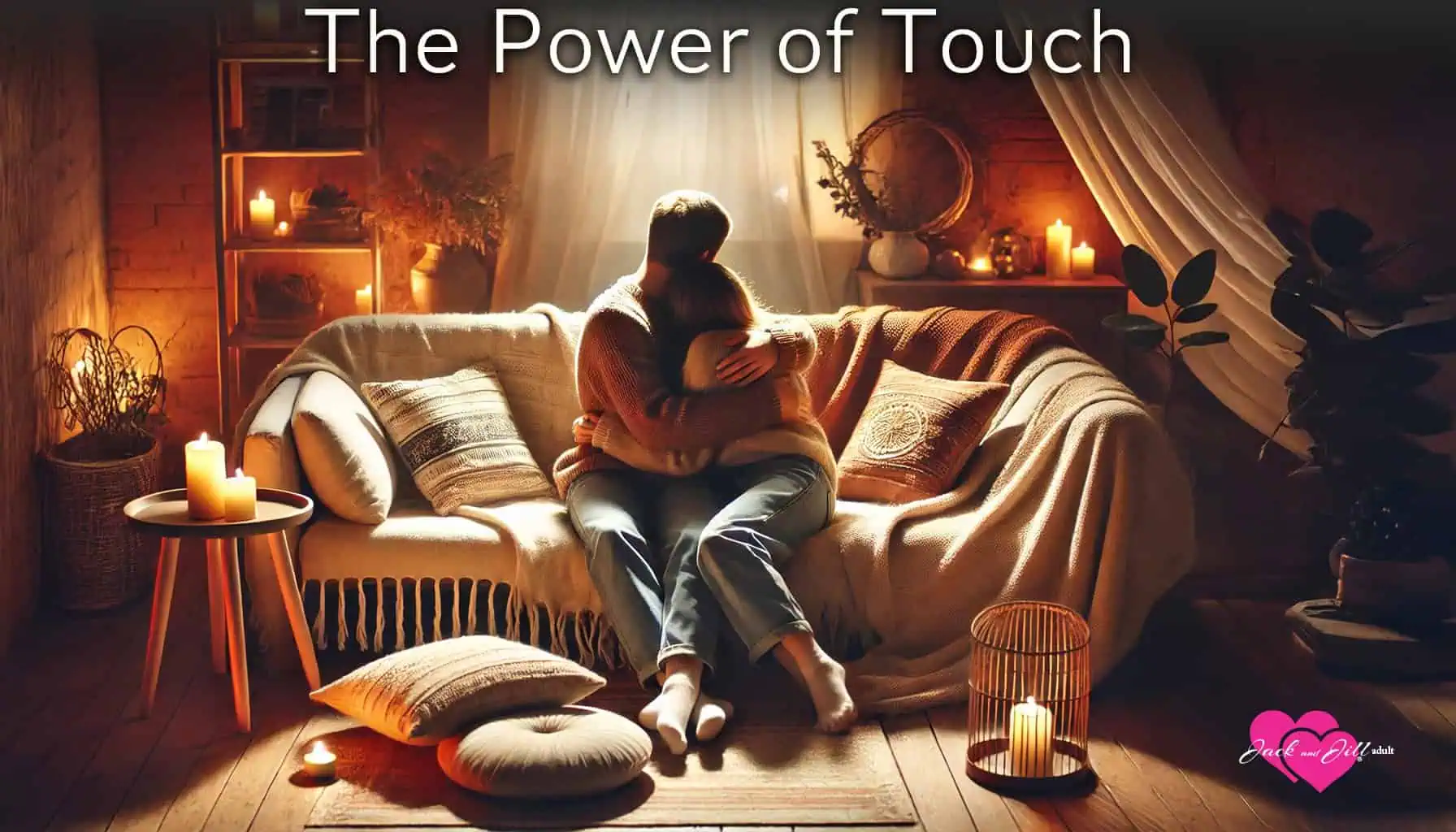
The Power of Touch
The simple power of touch often goes unnoticed in a world filled with constant distractions, busy schedules, and an emphasis on digital connections. For many couples, the concept of touch may be closely associated with intimacy and sexuality. But there’s a whole other dimension to physical connection that isn’t about sexual closeness.
Non-sexual touch, such as holding hands, cuddling, or a gentle touch on the arm, can be just as powerful in strengthening a relationship. This form of touch plays a crucial role in the human experience, enriching and shaping interpersonal relationships by enhancing emotional well-being, communication, and social bonding.
The Power of Physical Contact

Physical touch has profound effects on our well-being, which go beyond just feeling good. When we touch someone we care about, it triggers the release of oxytocin, often called the “bonding hormone,” which promotes feelings of trust and emotional security. Additionally, gentle touch helps reduce cortisol, the stress hormone, leaving us feeling calmer and more connected.
Touch also triggers a response in the vagus nerve, which is closely related to our capacity for compassion and emotional balance. This enhances overall well-being.
Science supports the idea that non-sexual touch is essential for mental health, helping individuals feel understood, valued, and grounded. For couples, these touches reinforce emotional closeness, enhancing feelings of comfort and security that lay the foundation for a strong partnership.
The Science Behind Touch
Touch is a complex and fascinating process that involves multiple sensory receptors and brain regions. It allows us to perceive and interpret various types of touch, from gentle caresses to firm handshakes. When we experience touch stimulates the brain’s reward centers, releasing dopamine and endorphins, leading to feelings of pleasure and relaxation.
One of the key players in this process is the body’s vagus nerve, which is responsible for transmitting sensory information from the skin to the brain. This nerve plays a crucial role in processing touch and can help lower blood pressure, heart rate, and cortisol levels, indicating its potential benefits for physical and mental health.
The Touch Research Institute has conducted extensive studies on the effects of touch, demonstrating its positive impact on physical and emotional well-being. Their research shows that touch can stimulate the release of oxytocin, often called the “cuddle hormone,” which is involved in social bonding and attachment.
Interestingly, the brain can distinguish between emotional and non-emotional touch thanks to specific emotional information receptors. Recent studies have shown that we can identify other people’s basic emotions based on how they touch us, even when separated by a curtain. This highlights the profound impact touch can have on our mental well-being.
Why Non-Sexual Touch Matters

Non-sexual touch, often called the human touch, communicates love and affection without expectation, creating a safe space for partners to express warmth and care. Small gestures, like a soft hand squeeze or resting your head on your partner’s shoulder, often feel as intimate as grand romantic gestures. They provide reassurance and closeness in a way that builds connection over time.
In long-term relationships, where physical touch can sometimes become less frequent or feel more routine, rediscovering the importance of non-sexual touch can bring new vitality. By separating touch from more profound ones, couples can experience deeper forms of connection, fostering a relationship where affection flows freely and comfortably.
Types of Non-Sexual Touch to Reinforce Connection
There are countless ways to show affection through touch. Here are some simple yet meaningful types of non-sexual physical contact that can enhance connection:
- Holding Hands is one of the most symbolic and universally understood gestures of unity. Holding hands while walking, sitting, or even during a movie shows togetherness and silently communicates, “We’re in this together.”
- Cuddling and Snuggling: Cuddling can be an incredibly comforting experience, especially after a long or stressful day. It doesn’t have to lead to anything beyond sharing warmth and a sense of closeness.
- Gentle Touch on the Arm or Back: A gentle pat or touch on the arm, shoulder, or back is a gesture. It’s a subtle way to show support and presence, perfect for moments when words aren’t necessary.
- Sitting Close: Sitting near each other while watching TV, sharing a meal, or reading can cultivate a quiet sense of unity. Physical proximity can make couples feel emotionally closer, even in silence.
These types of non-sexual touch are part of body language and serve as powerful nonverbal cues in social interactions.
Cultural and Social Aspects of Touch

Physical contact is a fundamental aspect of human interaction, with different cultures and societies having varying norms and expectations around touch. In some cultures, touch is a common way of greeting or showing affection, while in others, it is reserved for intimate relationships.
Touch is vital in maintaining emotional connections and intimacy. Studies indicate that couples who engage in regular physical touch tend to have stronger relationships.
However, personal space and boundaries around touch can vary significantly between individuals and cultures. Respecting and communicating about physical contact is important to ensure comfort and mutual understanding.
Massage therapy has gained popularity as a professional form of touch that helps reduce stress and improve overall well-being. Pregnant women, in particular, can benefit from touch therapy, with studies showing that regular massage can reduce pain and anxiety during pregnancy.
Even casual forms of touch, such as chest bumps or high-fives, can positively impact our emotional state and social connections. These simple gestures can enhance our sense of belonging and emotional well-being, underscoring the importance of touch in our daily lives.
Finding Time for Touch in a Busy Life
With busy lives and multiple commitments, making time for touch may require conscious effort. Here are some easy, realistic ways to incorporate touch into your daily routine:
- Morning and Evening Hugs: A quick embrace at the start or end of each day can help couples feel connected, even when time is short.
- Handholding During Walks: If you enjoy walking together, try holding hands or linking arms—it’s a simple way to feel close without extra effort.
- Cuddling Before Sleep: Spend a few minutes in bed before drifting off. This comforting ritual can set a relaxed tone for sleep and create a moment of togetherness.
Incorporating touch into daily routines fosters emotional connections and provides significant physical health benefits, such as improved emotional balance and overall well-being.
These small gestures may seem minor, but they become influential over time, reinforcing connection and creating a sense of intimacy in everyday moments.
Overcoming Barriers to Physical Closeness for Physical Health Benefits

It’s natural for some couples to find it challenging to reintroduce non-sexual touch, significantly if they’ve grown out of the habit; fatigue, distractions, or a sense of disconnection can make touch feel difficult or awkward. Touch can help reduce the stress hormone cortisol, promoting emotional well-being and mitigating stress. Here are some ideas to overcome those barriers:
- Start Small: Begin with just one gesture daily, such as a hand squeeze or a pat on the shoulder. There’s no need for grand gestures; gradually, the goal is to reintroduce physical connection.
- Communicate Openly: If something’s missing, talk with your partner about it. Express a desire for a more non-sexual touch in a positive, non-pressuring way.
- Make It Routine: Adding a quick hug or cuddle to your daily routine can make it feel more natural. Rituals around touch help couples stay close, especially during stress or disconnection.
The Emotional Connections of Non-Sexual Touch
Non-sexual touch can help repair small emotional rifts, rebuild trust, and make each partner feel valued and appreciated. In difficult moments, a gentle touch serves as a reminder of mutual love and commitment. When words fall short, touch can bridge gaps, offering comfort and understanding.
Couples prioritizing touch often feel more grounded in their relationships and have greater emotional resilience. These comforting rituals can signal care, reduce stress, and make both partners happier and more secure.
Conclusion
Touch doesn’t have to be elaborate or planned to be powerful. Small moments of physical connection—like holding hands, sitting close, or a gentle squeeze on the shoulder—are quiet yet powerful ways to reinforce intimacy. Non-sexual touch allows couples to feel valued and connected without the pressure of expectation, reminding them of the love and support they share every day.
Ultimately, making time for non-sexual touch in our relationships can be one of the most effective ways to strengthen bonds, build more profound resilience, and create a deeper sense of togetherness. Rediscovering touch means rediscovering connection, and in today’s fast-paced world, these simple moments of physical closeness are more essential than ever.

